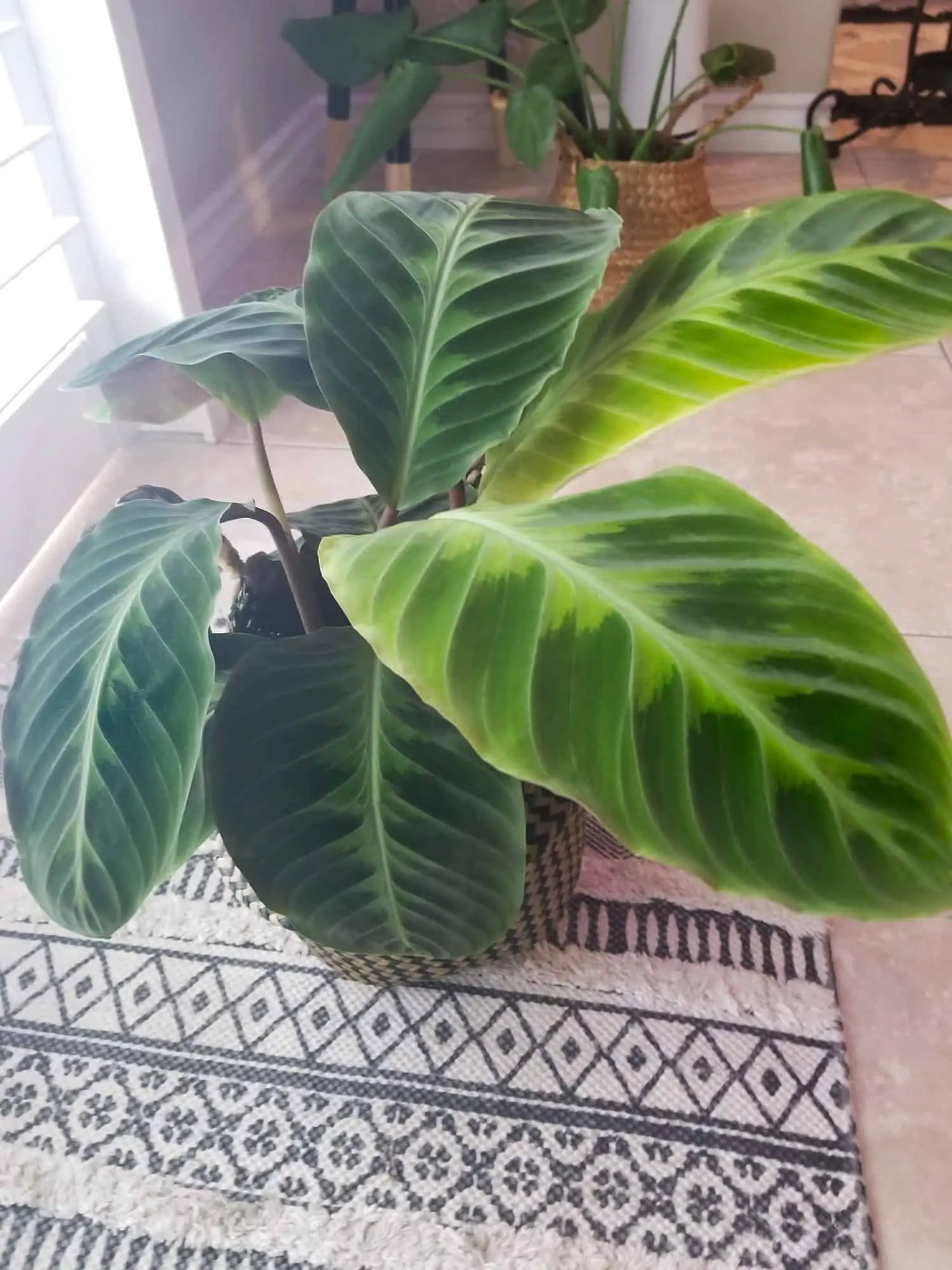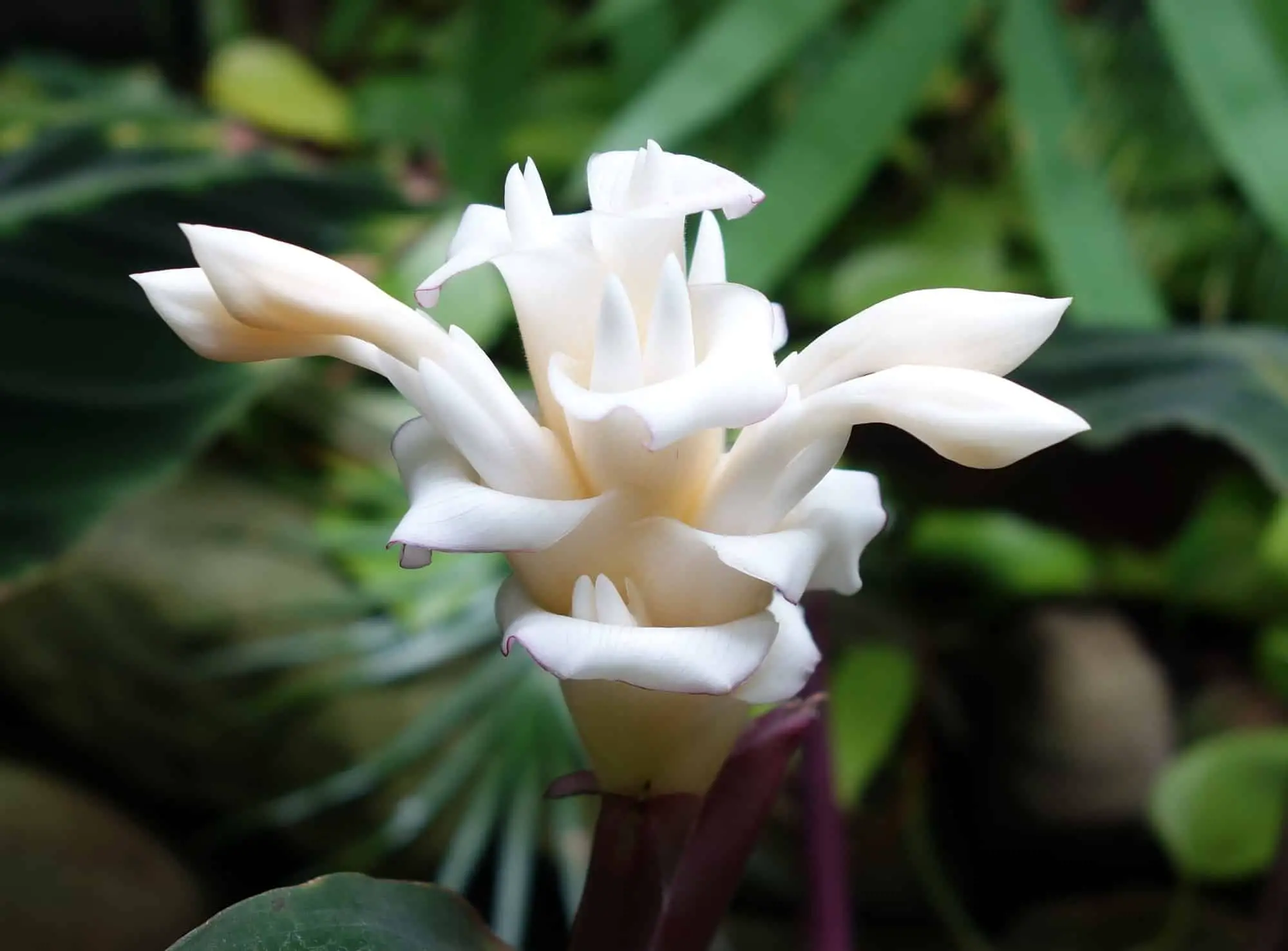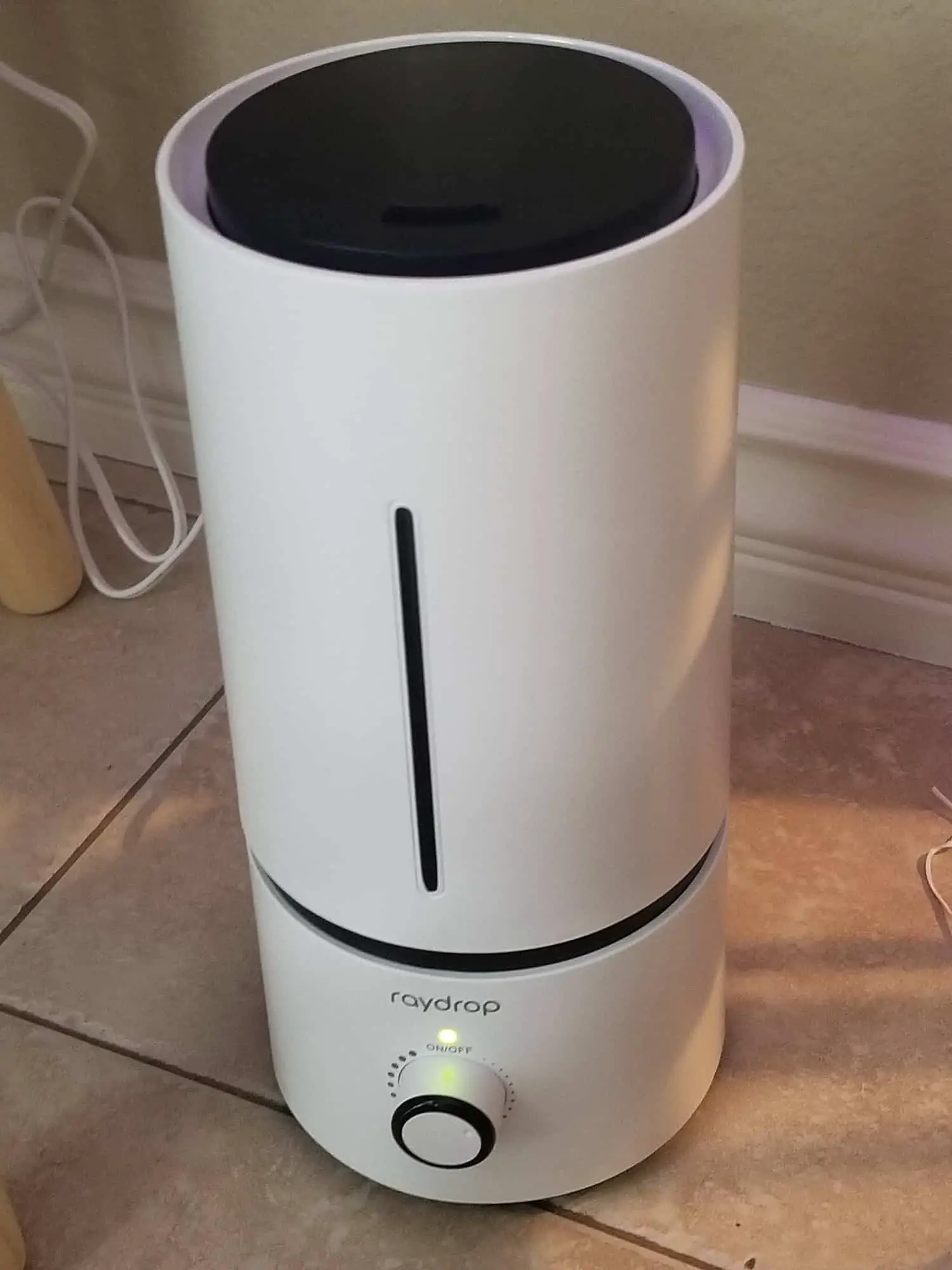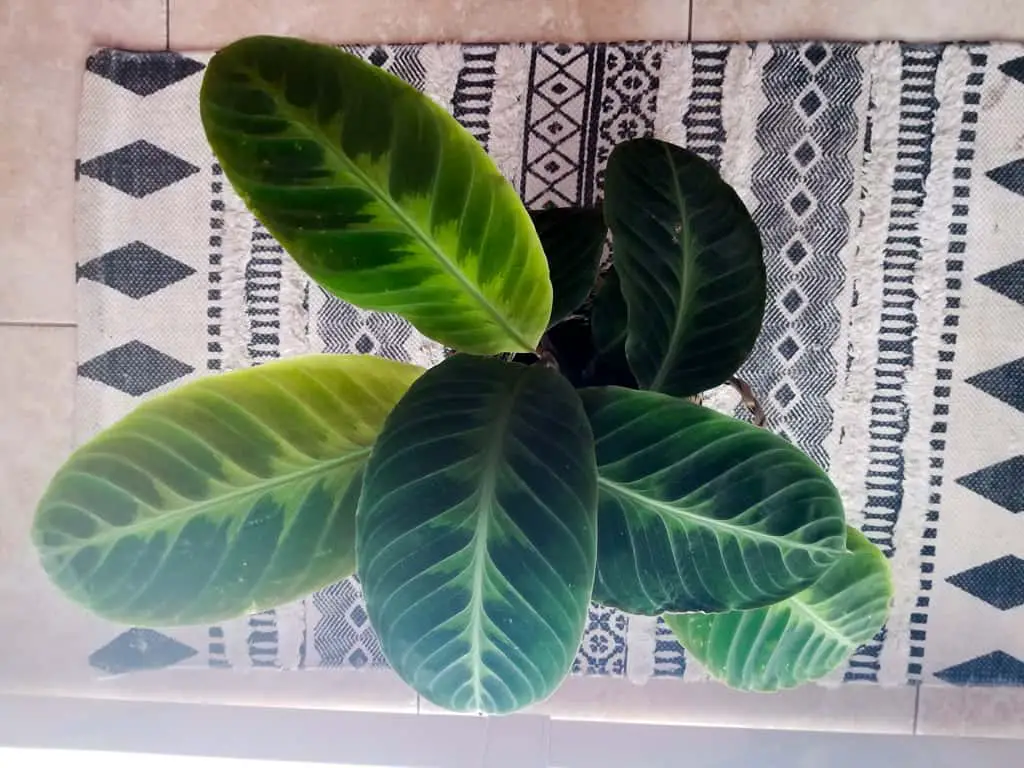Calathea warscewiczii, which is commonly known as Calathea Jungle Velvet, is a houseplant that is prized for its beautiful patterned leaves. The top of the leaves are two tones of green, and the bottom of the leaves is a burgundy color. I found this plant at the plant nursery a couple of weeks ago and fell in love. I have been able to keep my Red Prayer Plant alive for a couple of months, so I felt comfortable purchasing the plant. To learn more about this plant’s care requirements, I did a little research.
Calathea warscewiczii grows best in medium light conditions and should be watered lightly every couple of days with distilled water. To prevent root rot, water less frequently during the winter months. Calathea warscewiczii grows best in warm, humid environments, so they do best when kept near a humidifier and away from vents or drafty windows.
The rest of this article will provide some background on this plant’s natural habitat and include a detailed care guide for Calathea warscewiczii. Calatheas have earned a reputation for being a bit temperamental. This article will help you keep learn how to keep your Calathea warscewiczii happy and thriving despite its fussy nature.
Quick Guide To Plant Care For Calathea warscewiczii
| Scientific Names | Calathea warscewiczii Goeppertia warszewiczii |
| Common Name | Calathea Jungle Velvet |
| Light Requirements | Medium filtered light Note: Brown/yellow burn spots are signs of too much light |
| Watering Requirements | Water lightly every couple of days in order to keep the soil constantly moist (not soaked). Note: These plants are sensitive to chlorine and minerals. For this reason, it is best to use rainwater or distilled water for these plants. |
| Soil | Peat-rich potting mix with perlite for improved drainage |
| Fertilization | Once per growing season (spring/summer) with a balanced fertilizer diluted to half-strength. |
| Temperature | 65oF (18oC) to 85oF (30oC) |
| Humidity | 50% to 70% Note: These plants do best near a humidifier. Crispy leaves are a sign of inadequate humidity. |
| Toxicity | Not toxic to humans or animals. |
About Calathea warscewiczii

Calathea warscewiczii is a tropical plant that is native to Costa Rica and Nicaragua. This plant is well-known for the velvety texture of its leaves. This velvet texture can be attributed to little hairs that grow on the leaf surface. These hairs reflect light to reduce transpiration and protect the plant from hot weather.

In their native habitat, Calathea warscewiczii grows under the canopy of other trees rather than in direct sunlight. In the wild, Calathea warscewiczii can grow to a height of about 40 inches and a width of 20 inches.
Calathea warscewiczii belongs to the Calathea genus and the Marantaceae (Prayer Plant) family. Like other Calatheas, this plant is typically kept for its beautiful foliage. Although Calathea warscewiczii was recently re-assigned to the Goeppertia genus (this name change will be discussed later in this blog post), the leaves have a very similar appearance to other Prayer Plants.
Like some other types of Prayer Plant, Calathea warscewiczii will move throughout the day. This movement is called nyctinasty, and it is a response to the onset of darkness. Although Calathea warscewiczii does display some movement throughout the day, its leaves will not move as noticeably or dramatically as the leaves of the Red Prayer Plant.
Taxonomic Change For Calathea warscewiczii
Calathea warscewiczii was recently renamed Goeppertia warszewiczii. However, this taxonomic change has not been universally adopted. The name change is the result of an effort to refine previously incomplete taxon sampling. As part of this effort, researchers analyzed DNA sequence data from three plastid markers and one nuclear marker. The results of this study indicated that it was appropriate to classify some species, including Calathea warscewiczii, as Goeppertia rather than Calathea (Borchsenius et al., 2012).
Calathea warscewiczii Blooms
In its native habitat, Calathea warscewiczii will flower during the late winter or early spring, and the flower will last for 3-4 weeks. Unfortunately, these plants typically do not flower when kept as houseplants.

Lighting Requirements For Calathea warscewiczii
Calathea warscewiczii grows best when placed in a location that receives filtered medium light. These plants tend to do well next north and east-facing windows. Direct light or even bright light from a south-facing window can cause scorched leaves. Scorched leaves will have brown or yellow marks. These marks are like scars in that the damage cannot be reversed. However, if the brown/yellow coloring is not spreading, the damage is probably cosmetic rather than a sign of a dying plant.
In addition to scorched leaves, the leaf pattern will begin to fade if your Calathea warscewiczii is exposed to too much light.
If Calathea warscewiczii is not receiving enough sunlight, plant growth will slow down or stop altogether. Dull leaf coloring may also be an indication of too little sunlight. Although Calathea warscewiczii is considered a “low-light” plant, it still needs some light to survive. Do not be afraid to move your plant around and experiment with different spots within your home. Just keep a close eye on how your plant responds to changes in light.
Watering Requirements For Calathea warscewiczii
Calathea warscewiczii needs constantly moist (not soaking wet) soil. This means that these plants grow best when they are given a little bit of water every couple of days. Many plant parents are used to watering their plants on a set schedule. Unfortunately, these plants are not well-suited to a set watering schedule. Instead, it is best to check the soil moisture every day and act accordingly. You can use a moisture meter or the “finger test.” Simply stick your finger in the soil. Add water if the top 1/2″ to 3/4″ of soil is dry.
The water you use for this plant is also important. Calathea warscewiczii is sensitive to chlorine and salts that are commonly in tap water. It is best to use rainwater or distilled water for your Calathea warscewiczii. Alternatively, use filtered water or leave tap water out for 8-12 hours in order to allow the chlorine to evaporate.
Watering Tips:
- Use tepid water to avoid stressing the plant.
- Water less frequently during the winter months.
- Water during the morning hours so the plant has the opportunity to take up the water throughout the day.
Fertilizing Calathea warscewiczii
Like other Calaetheas, Calathea warscewiczii does not require a lot of fertilizer. Fertilizing once or twice per growing season with a balanced fertilizer that is diluted to half strength is sufficient.
Because Calathea warscewicziii is sensitive to salt, it is important to flush the soil every couple of months to prevent salt buildup.
Ideal Temperature Range and Suitable Humidity Levels For Calathea warscewiczii
Calathea warscewiczii does best in temperatures between 65oF (18oC) and 85oF (30oC). If the humidity is high enough, it can tolerate temperatures as high as 85oF.
While most tropical plants prefer humid conditions, Calathea warscewiczii is particularly sensitive to low humidity. The plant’s leaves will get brown and crispy if it is in an environment that is too dry.
Most homes have an average relative humidity of 30 to 60 percent. It is also important to note that homes tend to be drier (have a lower humidity) during the winter months. To increase the humidity in the vicinity of your plant, I recommend purchasing a little humidifier to put near your Calathea warscewiczii (and other tropical plants). You can purchase a small humidifier on Amazon for under $25.

If you do not have a humidifier, I recommend putting your plant in the shower overnight. This will allow the plant to enjoy the humidity of your bathroom without sacrificing the opportunity to soak up some light during the day.
I have read several articles that recommend misting your plant’s leaves to compensate for dry conditions. Unfortunately, misting does not help very much and can cause fungal diseases. For this reason, I recommend not misting your plant. If you must mist your plant, use distilled water to avoid leaf burn from the salts and chlorine often found in tap water.
Best Soil Mix For Calathea warscewiczii and Repotting Calathea warscewiczii
Soil is a critical part of plant health. Because Calathea warscewiczii plants like to be in moist soil at all times, they should be planted in a growing medium that retains some water. For this reason, it is best to grow these plants in a peat-based soil mix. I recommend using a soil mix that is comprised of one part peat and one part perlite.
Propagating Calathea warscewiczii
Calathea warscewiczii can be propagated by division during the spring. These plants really do not like to have their roots disturbed, so it is important to be very gentle when pulling apart the rhizomes (shallow roots).
Potential Pest Problems For Calathea warscewiczii
The most significant pest problem Calathea warscewiczii owners face is spider mites. Spider mites tend to show up during the dry, winter months. To prevent a spider mite infestation, use a humidifier to keep the humidity up.
Signs of a spider mite infestation include yellow/brown spotting and webbing. Spider mites are typically found on the underside of the plant leaves.
If you notice that your plant has a spider mite problem, immediately separate it from your other houseplants to prevent the infestation from spreading. To get rid of spider mites, spray the leaves with distilled water or wipe down the leaves with a damp sponge. If that does not help, you may have to resort to insecticidal soap. While effective, insecticidal soap may damage your plant’s leaves significantly. However, this sacrifice may be worth it because spider mites will kill your plant if they are allowed to continue feeding on the leaves.
Is Calathea warscewiczii Toxic?
Calathea warscewiczii is not toxic to humans and pets. However, I have heard that cats like to rip up the leaves, so consider placing your Calathea warscewiczii on a high shelf if you have pets.

